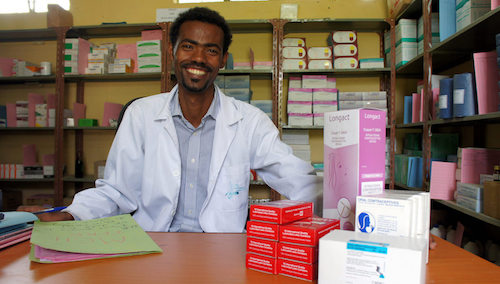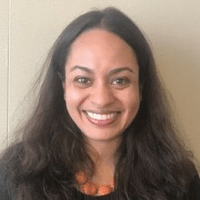Interview: How USAID is Capitalizing on New Trends in Development Finance
Tuesday, November 7, 2017

Bussa Heath Center Drugstore in Ethiopia, which is managed in partnership with USAID and the Ministry of Health. (Image credit: USAID via Flickr).
Andrea Bare is a senior advisor with the William Davidson Institute , where she partners with donor, consulting and implementing organizations to analyze global health markets and advance private sector solutions. Bare’s interview with Priya Sharma of USAID’s Center for Accelerating Innovation and Impact, originally appeared on NextBillion.net, an affiliated site of the Institute.
By Andrea Bare
As the funding landscape for global health evolves, new financing models for the development and commercialization of medicines and diagnostics are needed. Priya Sharma of USAID’s Center for Accelerating Innovation and Impact discusses the agency’s forays into impact investing, and its recent report, “Investing for Impact: Capitalizing on the emerging landscape for global health financing” in this Q&A.
When it comes to the development and commercialization of medicines and diagnostics in the U.S. and developed economies, questions of investment and impact follow a familiar equation: Pharmaceutical executives focus on what makes a good investment, while insurers, national health systems, donors and other payers press for what has the most impact.
It is not surprising that global health actors are increasingly tackling this challenging equation as well. As the funding landscape for development evolves, new financing models are needed. Private investment elevates the opportunity to achieve both financial return and social impact.
I recently caught up with Priya Sharma, senior policy and innovative financing advisor in the Center for Accelerating Innovation and Impact (CII) within USAID’s Global Health Bureau. We discussed USAID’s recent report, “Investing for Impact: Capitalizing on the emerging landscape for global health financing.”
Here are some highlights from our conversation.
AB: What is USAID’s goal behind the Investing for Impact report?
 PS: We sought to highlight the movement in development finance and provide an educational resource to make the case for why it’s important for USAID to start working more with the private sector. The fact that private capital, both within countries and internationally, is outpacing donor financing in low- and middle-income countries (LMICs) is significant. Forty years ago, three out of every four dollars sent from the US to the global south came in the form of official development assistance (ODA). Today, approximately 80 percent of resource flows from the U.S. to emerging and developing economies come in the form of foreign direct investment or sources other than ODA. USAID will remain an important player, but we will have to work differently.
PS: We sought to highlight the movement in development finance and provide an educational resource to make the case for why it’s important for USAID to start working more with the private sector. The fact that private capital, both within countries and internationally, is outpacing donor financing in low- and middle-income countries (LMICs) is significant. Forty years ago, three out of every four dollars sent from the US to the global south came in the form of official development assistance (ODA). Today, approximately 80 percent of resource flows from the U.S. to emerging and developing economies come in the form of foreign direct investment or sources other than ODA. USAID will remain an important player, but we will have to work differently.
Our intent with Investing for Impact is to build understanding among USAID and development practitioners, foster a common language and highlight different tools. We make a case for continuing USAID’s current way of working but to also expand the paradigm so that when designing new projects, we actively consider the potential to leverage private funding.
AB: What are major or persistent challenges in impact investing from USAID’s vantage point?
PS: The challenge is linking appropriately designed capital with priority opportunities in global health. There are many good early stage health social enterprises (HSEs), but they may not be “investable” from the funder’s point of view. An impact investor looks for a business that is already financially viable, but promising HSEs may still require substantial technical assistance, pose a high or uncertain risk, or require a long time horizon for a return. From the USAID perspective, we want to support the pipeline and address these concerns to draw in the investment community. I’d like to see what we can do to bring more private capital in the earlier-stage, to prepare innovations for scale-up.
AB: Can you elaborate on Lulama, one of the investments cited in the study?
PS: Lulama is an excellent example of a public-private partnership addressing the development challenge of access to affordable and quality assured medicines in South Africa’s underserved areas. We are targeting the business challenges faced by private independent pharmacies. As the main source for medicines in many hard to reach communities, these pharmacies need access to quality assured commodities, business management assistance, and access to credit. USAID is working with Absa Bank, Aspen Pharmacare, GlaxoSmithKline, Imperial Health Sciences, Pharmed, and Pfizer to create Lulama, an innovative financing partnership that provides a comprehensive solution to support independent pharmacies, including proving them with access to much needed credit. To facilitate this process, USAID purchased insurance against the risk of pharmacies defaulting, unlocking $6.5 million in credit from a commodity wholesaler in South Africa. Interestingly, USAID and the pharmaceutical companies are risk sharing. The insurance only covers 50 percent of the wholesaler’s loss. The pharmaceutical companies cover the remaining 50 percent in the form of credit on the wholesaler’s next purchase from companies. The initiative anticipates averting 200,000 deaths due to improved access to medicine as Lulama scales in South Africa.
AB: How does this work link with USAID CII’s 2015 publication, “Financing Framework to End Preventable Child and Maternal Deaths”?
PS: The development financing dialogue has accelerated rapidly since 2015 and we felt that more context is needed. The Financing Framework presented tools for diagnosing financing issues as factors that are unique but may be overlooked in assessing the root causes of global health challenges. Here we delve into the changing landscape of global health financing and why private sector investment matters.
AB: Are impact investors comparably interested in health-related service as well as product innovation?
PS: If it’s a product, it’s a bit easier. It’s possible to understand how a product or technology can generate revenue. With a new service delivery model, it’s a more difficult to make a business case. But many investors also understand that a good new product is not enough. You also need the provider training, the demand generation, and an effective supply chain. There has to be an actor developing the market in-country for both demand and supply. This is an example of the potential synergy – private capital can invest in the technology and philanthropic partners in the enabling environment and market access.
There are service delivery models which are very replicable and scalable and those are certainly attractive investments. Cataract surgery like the Aravind model is a great case study for something that creates a social good but also has a solid business case. We want to find and support the development of Aravinds in other sub-sectors.
AB: How does USAID address scale in impact investing?
PS: Much depends on the innovation. There will be variation in what we can define as scale. What success looks like will vary vastly based on the innovation as well as the country context. If it’s a product, it’s easier to see how scale could be regional or global. However, many solutions are local—they are developed in the very communities that they are trying to help. In that case, scale might be reaching full coverage in that community, county or state.
We can achieve impact in a pilot project, but if we are to achieve our health goals and development goals, we need scale. That is not something that USAID can fund on its own, this is where the private sector can help.
AB: How do you create the pipeline and then move forward to funding?
PS: Multiple approaches are possible. The Grand Challenge model and similar challenge funds are fruitful ways to identify opportunities. We also have prizes and other pull mechanisms. USAID and other donors provide the seed funding to prove concepts. More recently, brokering and matchmaking platforms have emerged, such as Convergence, and the Every Woman and Every Child (EWEC) Innovation Marketplace, to link promising innovations to follow-on funding. These opportunities are a start but we still need a way to bring in more and different types of investors. For example, is there a way we can de-risk investment to catalyze additional funding from the private sector? Can we pool different types of capital to better meet the needs of HSEs and help them grow? These are questions we are actively exploring. We will pursue ways to be more purposeful and inclusive.
AB: How does country readiness inform the potential for impact investing?
PS: This is a critical question, as each country is so different. This will be a big hurdle and if we can get this right, it will help funding flow. Regulation, tax incentives, and restrictions on investor entry are all critical pieces that need to be thought through. Each country will negotiate this in its own way, and we can partner with impact investors to jointly assess these enabling environment factors.
AB: The report profiles several investment tools. Which one of these best align with impact investing?
PS: The flexible grant funding and the credit guarantee align best. We use flexible grant funding for pipeline generation, demand generation, to provide technical assistance, incubation and acceleration support. We use flexible grant capital for de-risking, either by supporting an individual HSE or by creating public goods like broader demand generation, investing alongside investors to increase confidence with the development enterprise. The Development Credit Authority (DCA) is probably the most powerful tool that USAID possesses. There are various ways that we can think about de-risking investment through this mechanism.
AB: What does the long-term look like for USAID in terms of impact investing?
PS: This will have to be a multi-stakeholder effort. USAID is not the solution but we can play an important role. We need a true partnership between public and private sectors to try and solve this problem of reaching scale with new business models, to understand where each fits in. This will not happen overnight, but if we manage to get the right partners together and to consider solutions, it could be game changing.
It’s been estimated that achieving the Sustainable Development Goals (SDGs), will require $4.5 trillion per year. That is not feasible with the current model of development. Part of the solution will be to recognize the role of non-traditional and new players such as the private philanthropic sector and impact investors. USAID will need to figure out how to attract them to the development space and how to work with them. This is the new model of development and this is how we will achieve the SDGs.
